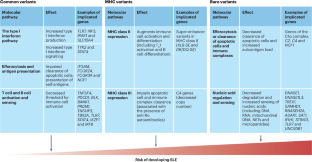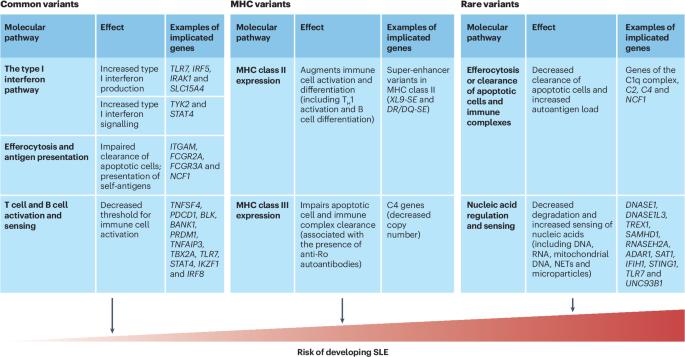Systemic lupus erythematosus genetics: insights into pathogenesis and implications for therapy
IF 29.4
1区 医学
Q1 RHEUMATOLOGY
引用次数: 0
Abstract
Systemic lupus erythematosus (SLE) is a prime example of how the interplay between genetic and environmental factors can trigger systemic autoimmunity, particularly in young women. Although clinical disease can take years to manifest, risk is established by the unique genetic makeup of an individual. Genome-wide association studies have identified almost 200 SLE-associated risk loci, yet unravelling the functional effect of these loci remains a challenge. New analytic tools have enabled researchers to delve deeper, leveraging DNA sequencing and cell-specific and immune pathway analysis to elucidate the immunopathogenic mechanisms. Both common genetic variants and rare non-synonymous mutations can interact to increase SLE risk. Notably, variants strongly associated with SLE are often located in genome super-enhancers that regulate MHC class II gene expression. Additionally, the 3D conformations of DNA and RNA contribute to genome regulation and innate immune system activation. Improved therapies for SLE are urgently needed and current and future knowledge from genetic and genomic research should provide new tools to facilitate patient diagnosis, enhance the identification of therapeutic targets and optimize testing of agents. This Review explores the genetic basis of systemic lupus erythematosus, including the role of enhancers in the MHC region, the 3D structure of DNA and various pathway-specific mechanisms. These findings enhance disease understanding and inform improved diagnosis and treatment strategies.


系统性红斑狼疮遗传学:对发病机制的认识和对治疗的影响
系统性红斑狼疮(SLE)是遗传和环境因素相互作用引发系统性自身免疫的一个典型例子,尤其是在年轻女性中。虽然临床疾病需要数年时间才能显现,但个人独特的基因构成决定了患病风险。全基因组关联研究已经确定了近 200 个系统性红斑狼疮相关风险基因位点,但要揭示这些基因位点的功能效应仍是一项挑战。新的分析工具使研究人员能够深入研究,利用DNA测序和细胞特异性及免疫通路分析来阐明免疫致病机制。常见的基因变异和罕见的非同义突变会相互作用,增加系统性红斑狼疮的风险。值得注意的是,与系统性红斑狼疮密切相关的变异往往位于调控MHC II类基因表达的基因组超级增强子中。此外,DNA 和 RNA 的三维构象也有助于基因组调控和先天性免疫系统的激活。目前急需改进系统性红斑狼疮的治疗方法,而遗传学和基因组研究目前和未来的知识应能提供新的工具,促进患者诊断、加强治疗目标的识别和优化药物测试。
本文章由计算机程序翻译,如有差异,请以英文原文为准。
求助全文
约1分钟内获得全文
求助全文
来源期刊

Nature Reviews Rheumatology
医学-风湿病学
CiteScore
29.90
自引率
0.90%
发文量
137
审稿时长
6-12 weeks
期刊介绍:
Nature Reviews Rheumatology is part of the Nature Reviews portfolio of journals. The journal scope covers the entire spectrum of rheumatology research. We ensure that our articles are accessible to the widest possible audience.
 求助内容:
求助内容: 应助结果提醒方式:
应助结果提醒方式:


